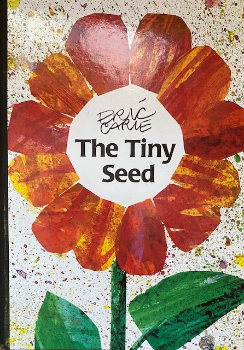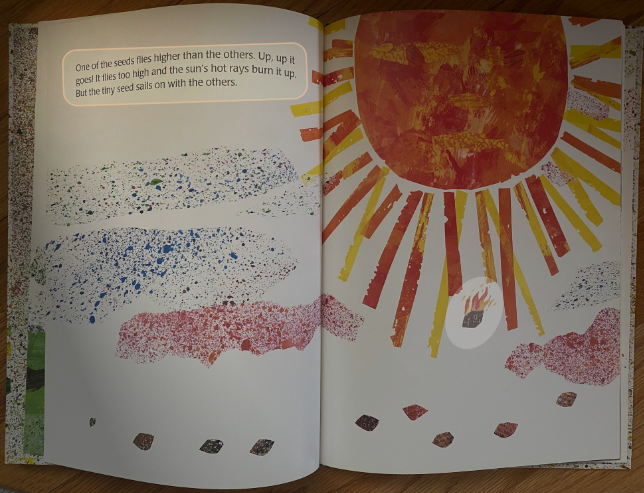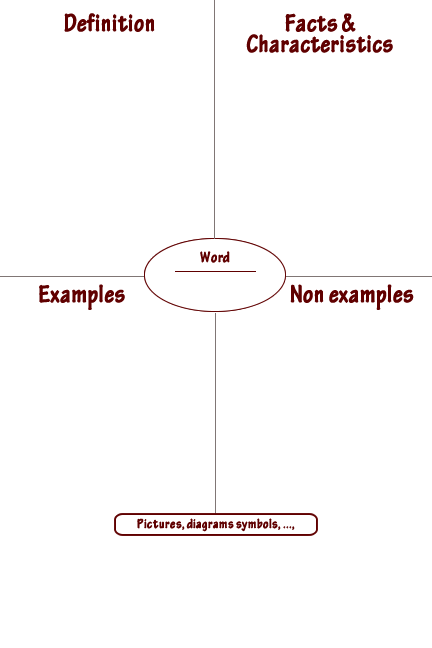The Tiny Seed by Eric Carle

The Tiny Seed by Eric Carle, written in 1970, is a story about the life cycle of a seed.
It is a colorful picture book in a style, that is recognized by young and old as distinctly illustrated by Eric Carle.
The character is a tiny seed, smaller than the others. Set over four seasons, in which the seed is blown away, and we are told aboiut its journey to becoming a plant, growing, flowering, and producing seeds.
The personification of the seed, and some of the exagerated situations, makes the story fiction, however, the overall life cycle is mostly nonfiction. Making it a good piece to discuss fiction, nonfiction, what makes quality literature, and exploring properties of flowering plants.
While I believe a story about seeds can be exciting, without the exagerations included in the book, it's inclusion opens the door for some great discussion about what makes a piece of literature fiction or nonfiction, what makes quality literature, and the science of flowering plants.
An activity to achieve this would start with some focus questions, reading of the book, discussion of the focus questions and anything else the readers want to dig into. For example, a deep dive into the information in the book and a review of the accuracy of its content (Information analysis table).
Then a grand discussion of whether it is fiction or nonfiction and quality literature. And making of a map, outline, or story about the life cycle of flowering plants could logically follow.
Focus questions
- Is The Tiny Seed quality literature?
- What genre is it?
- Is the information in the book accurate?
To answer this question we might want to know the genre of the book.
Fiction or nonfiction?
To answer this question we need to know ...
For example is the information on the following page, accurate?

What about information in the rest of the book?
Some information isn't always one thing or another so rather than looking at the information as true or false it may be better to consider a range of possibilites.
The following table lists the key ideas in the book to record information for each.
| Statement | Always | ................. | Sometimes | ................. | Never |
|---|---|---|---|---|---|
| Flowers make seeds. | |||||
| Seeds can be tiny. | |||||
| Seeds can be blown by the wind. | |||||
| Tiny seeds can be blown high enough for the sun to burn them up. | |||||
| There are tall mountains where ice never melts. | |||||
| Seeds can't grow on ice. | |||||
| Seeds will drown in ocean water. | |||||
| Seeds can't grow in a hot and dry desert. | |||||
| Birds eat seeds. | |||||
| Mice eat seeds. | |||||
| Seeds become plants with roots and stems. | |||||
| Seeds germinate at different times. | |||||
| Some plants grow faster than others. | |||||
| Weeds can take sun and rain from other plants. | |||||
| People can break plants so they stop growing. | |||||
| Plants have flowers. | |||||
| People pick flowers and give them to their friends. | |||||
| Plants can grow taller than people, trees, and houses. | |||||
| Flowers can grow to be giant. | |||||
| Birds, bees, and butterflies visit flowers. | |||||
| Flowers have seeds. | |||||
| Wind blows seeds far away. |
Extensions
- Use the Frayer model below to analize fiction and nonfiction.
- Use what you learned about seeds or flowering plants and make a map, web, diagram, Frayer model, or write a story that describes seeds, flowers, or the life cycle of flowering plants.
Frayer model
